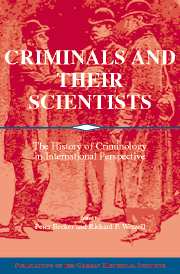Book contents
- Frontmatter
- Introduction
- Part One Nonacademic sites of Nineteenth-Century Criminological Discourse
- Part Two Criminology as Scientific and Political Practice in the Late Nineteenth and Early Twentieth Centuries
- 6 Cesare Lombroso and Italian Criminology: Theory and Politics
- 7 Criminal Anthropology: Its Reception in the United States and the Nature of Its Appeal
- 8 From the “Atavistic” to the “Inferior” Criminal Type: The Impact of the Lombrosian Theory of the Born Criminal on German Psychiatry
- 9 Criminology, Hygienism, and Eugenics in France, 1870-1914: The Medical Debates on the Elimination of “Incorrigible” Criminals
- 10 Crime, Prisons, and Psychiatry: Reconsidering Problem Populations in Australia, 1890-1930
- 11 Positivist Criminology and State Formation in Modern Argentina, 1890-1940
- 12 The Birth of Criminology in Modern Japan
- Part Three The Making of the Criminologist
- Part Four Criminology in the First Half of the Twentieth Century: The Case of Weimar and Nazi Germany
- Index
6 - Cesare Lombroso and Italian Criminology: Theory and Politics
Published online by Cambridge University Press: 05 January 2013
- Frontmatter
- Introduction
- Part One Nonacademic sites of Nineteenth-Century Criminological Discourse
- Part Two Criminology as Scientific and Political Practice in the Late Nineteenth and Early Twentieth Centuries
- 6 Cesare Lombroso and Italian Criminology: Theory and Politics
- 7 Criminal Anthropology: Its Reception in the United States and the Nature of Its Appeal
- 8 From the “Atavistic” to the “Inferior” Criminal Type: The Impact of the Lombrosian Theory of the Born Criminal on German Psychiatry
- 9 Criminology, Hygienism, and Eugenics in France, 1870-1914: The Medical Debates on the Elimination of “Incorrigible” Criminals
- 10 Crime, Prisons, and Psychiatry: Reconsidering Problem Populations in Australia, 1890-1930
- 11 Positivist Criminology and State Formation in Modern Argentina, 1890-1940
- 12 The Birth of Criminology in Modern Japan
- Part Three The Making of the Criminologist
- Part Four Criminology in the First Half of the Twentieth Century: The Case of Weimar and Nazi Germany
- Index
Summary
Cesare Lombroso is well known to historians and current criminologists alike, but he is often recognized for little more than contributing the notion of the “born criminal” to criminological theory. Yet his ideas were complex and changed significantly over his lifetime. A reductionist view of Lombroso's criminal anthropology is not the fault of the readers because many of his works have never been translated or were drastically shortened for foreign publication. Even for those scholars who read Italian it is difficult to locate copies of the various editions of his books. Those writings that are available tend to be discussed in a vacuum, without any understanding of their particular Italian context.
In this chapter I attempt to eliminate some of the imprecision that curiously envelops such a major figure in the history of criminology. First, I trace the evolution of parts of Lombroso's theory through an examination of the five editions of his seminal work, Criminal Man. Second, I examine the work of his disciple and colleague, Enrico Ferri, for the purpose of placing Lombroso within the wider circle of Italian intellectuals who formed the “Positivist School” of criminology. Although a collective portrait of the many adherents of this school is beyond the scope of this chapter, the analysis of Ferri will provide an example of the prominence of criminal anthropology within Italian academic circles.
- Type
- Chapter
- Information
- Criminals and their ScientistsThe History of Criminology in International Perspective, pp. 137 - 158Publisher: Cambridge University PressPrint publication year: 2006
- 57
- Cited by



